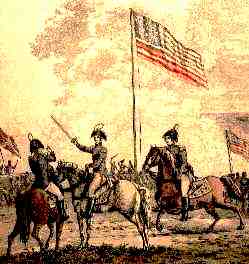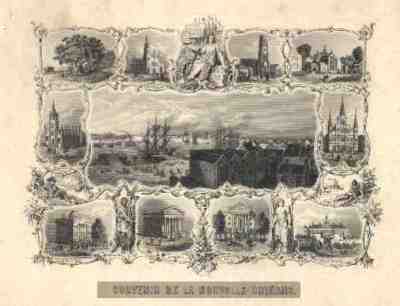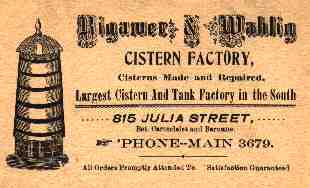

 | 
|
| On January 8 of each year New Orleanians remember the illustrious Battle of New Orleans with a reenactment of the historic engagement on the fields of Chalmette. Year-round memories of the battle are available to us through a number of books, original documents, and artistic renderings such as this engraving (see detail, above). [Louisiana Print Collection] | Most visitors to New Orleans' Audubon Zoo are likely unaware of the park's past as the site of our first World's Fair. The 1884 World's Industrial and Cotton Centennial Exposition transformed the old Foucher sugar plantation into an expansive public space that has evolved over the years into one of our finest attractions for residents and tourists alike. This contemporary broadside (see detail, above> reminds us of the massive buildings that graced the Exposition grounds. The Horticultural Hall remained in use by Audubon Park until it was damaged by the 1915 hurricane and later demolished. [Louisiana Print Collection] |
 | 
|
| Souvenirs are intended to provide us with continuing memories of the places and events from our past. This 1850s souvenir of the Crescent City helps us almost a century-and-a-half later to recall the appearance of several long lost local landmarks. [Louisiana Print Collection] | City officials probably used this sketch of the Henry Clay monument in planning its move from the intersection of Canal and St. Charles Streets to Lafayette Square in 1901. Only in the "Good Old Days" could such a massive public memorial been allowed to stand in the middle of one of the city's busiest intersections. [City Archives Collection] |
 | 
|
| Rex still parades on Mardi Gras and gives us all something worth remembering each year. This picture postcard reminds us not only that parade floats were once pulled by mules, not by tractors, but also that the king's float employed a more regal species to power it through the city's streets. [Louisiana Postcard Collection: Mardi Gras] | The now-demolished French Hospital on Orleans Avenue provides us with several diverse memories: of the days when the Frenchness of our population supported several Gallic benevolent and fraternal organizations, of Lee Harvey Oswald's birth there in 1939, and of civil rights pioneers A. P. Tureaud and Dutch Morial practicing law there following the building's sale to the Knights of St. Peter Claver. [Rare Vertical File: Handbills] |
 | 
|
| Before the Sewerage and Water Board succeeded in piping pure drinking water into the homes of New Orleanians cisterns were the means by which citizens collected and stored the essential liquid. Rigamer & Wahlig, along with twenty-two other cistern builders, are listed in the city directory for 1909, the year that the Water Board's purification plant went online. [Rare Vertical File: Business Cards] | The corner of Tulane and Loyola, mid-1950s. Since 1958, this has been NOPL's corner, but this is how it looked over 40 years ago, after the old courthouse and jail were razed, before the Tulane University Medical Center rose across the street and before the Trailways Bus station closed its doors. [Louisiana Photograph Collection. Municipal Government Collection; Department of Utilities Series] |
 | 
|
| The original Maison Blanche Building being demolished on Canal Street, ca. 1908. The new Maison Blanche that replaced it is one of the few "old" department stores still doing business on Canal Street today. Plans are underway to convert the largely vacant upper floors (once home to dozens of doctors' and dentists' offices) into a 245-room Ritz-Carlton Hotel. Many people believe that the future rebirth of Canal Street depends on the conversion of landmark buildings like MB and Holmes to new uses centered around the city's thriving tourist and convention market. [Louisiana Photograph Collection. Alexander Allison Collection] | The interior of the St. Roch Market, 2381 St. Claude, before improvements made by the WPA in 1937. In 1935, there were 19 public markets in New Orleans, the St. Roch among them. That year, the city considered closing the deteriorating building, but a petition by residents of the neighborhood argued that the market was "an absolute necessity." Instead, the city secured the help of the WPA to renovate the St. Roch Market and five other public markets. WPA workers replaced open stalls with refrigerated units, added protective glass to shield fish and fresh meat, installed new plumbing and concrete floors, and separated the fish and vegetable markets. Ten years later, however, the St. Roch Market was declassified as a public market and leased to a private owner. The market survives to this day on the St. Roch Avenue neutral ground at St. Claude. [Louisiana Photograph Collection. WPA Collection} |
Return to Beginning of Exhibit